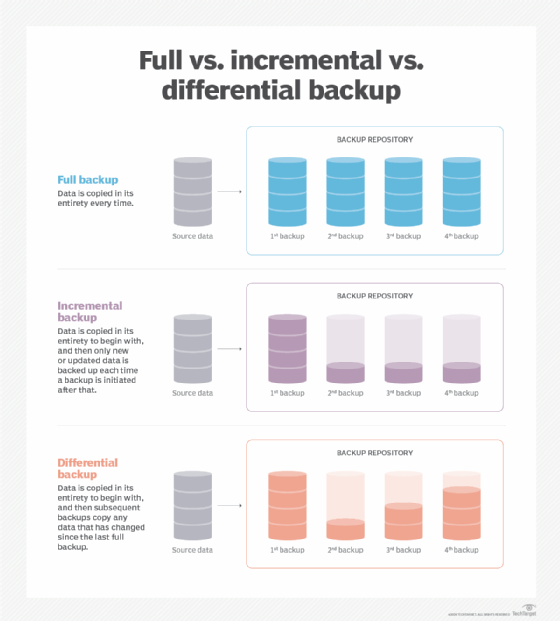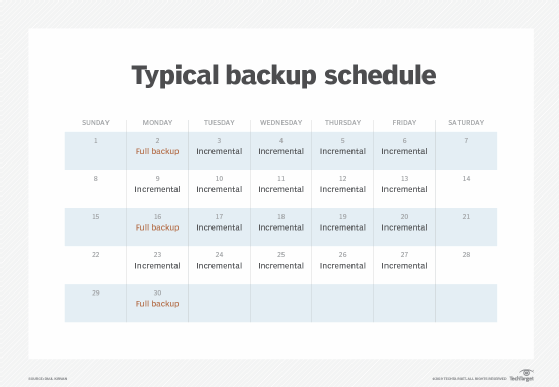Backup scheduling best practices to ensure availability
For daily work files, databases and mission-critical systems and data, the more frequent the backup, the better. But how often should you back up all your data?
With all the backup-focused products available today, there's no excuse not to back up systems and data. The key to making all of this work is having a backup schedule.
Knowing how to create a backup schedule and develop a thorough scheduling strategy is essential.
The principal goal of a backup schedule is establishing time frames to back up an entire system, multiple systems, data and databases, network files, and other critical systems and data.
Why is a backup schedule needed?
Backup schedules are essential IT activities, as they ensure the following vital functions are addressed:
- Disaster recovery. This task involves recovering and restarting critical systems, VMs, data files and databases.
- Defining start times and completion times for all regular backups. The schedule must include all data backup activities and testing activities. Any backup tools and network resources used should also be specified.
- Restoring files that have been accidentally deleted. We have all experienced this at some point, and it helps to have a safety net if work files or other critical data are erased.
- Gauging the effect of backup activities on production activities. A backup schedule can help keep systems operating at peak performance and allow backups to occur outside of production schedules.
- Satisfying compliance and audit requirements. Schedules can be essential sources of evidence for organizations that must comply with data protection regulations and standards and be periodically audited for general IT controls.
- Complying with recovery time and recovery point objectives. RTO and RPO are essential for managing data backup and recovery; schedules can demonstrate that these metrics are being addressed.
Key issues in backup scheduling
Although scheduling backups might seem like a no-brainer, several process components must be addressed within IT departments and reviewed with business unit leaders and senior management.
Addressing these items will ensure a comprehensive, auditable schedule that is easily understood and can be implemented by designated data backup team members and others in an emergency. Following is a list of key concerns for planning and executing data backups.
1. What needs to be backed up?
Data and system owners should specify the frequency of their backups and what should be backed up. Normally, data administrators should back up everything -- or specific parts -- in the IT environment with a frequency acceptable to business unit leaders and cost-effective operations.
Organizations should also consider the cost of backups and their effects on system -- and company -- performance. For example, it might make sense to replicate the entire system or critical portions of the system and specific individual files and databases to an alternate storage medium and perform incremental backups to that environment.
2. Location of systems and files to be backed up
Identify if the working location will be an on-site server, storage device or cloud-based backup. This can be included in the backup schedule and should also be specified in data backup policies and procedures, especially from compliance and audit perspectives.
3. Who performs backups?
A data backup administrator's activities should be governed by their discussions with all systems and data owners. If individual users back up their data files, this should be addressed by an IT policy for data management. Other IT employees should be identified as potential backup staff to the primary backup administrator(s). This might involve internal training from the data admins and vendors whose technology resources are used for backups.
4. Time frames for backups
Points in time when data and system backups can occur should be defined based on business requirements. For example, some systems and data files might need to be backed up as soon as they're modified. This reflects their criticality to the business. Full backups are often performed after business hours and over the weekend. More frequent backups are governed by the business, and their execution might depend on specific systems and network resources.
Several variables influence backup time frames:
- System or service that performs the backups.
- Location of the backups -- for example, on-site or remote.
- Time of day for performing backups.
- Use of mounted or unmounted file systems.
- RPO/RTO metrics to be satisfied.
- Requirements as specified by system/data owners and senior management.
Backup administrators should periodically consult with system owners on these criteria to ensure the appropriateness of backup policies, procedures and schedules.
5. How frequently do systems and data files need to be backed up?
Some files, such as customer data files, are updated often during the day, requiring admins to back up these files more frequently. They might consider backing them up at the end of each day -- factoring in all incremental revisions -- so that an up-to-date backup is saved.
Other situations might require files to be backed up immediately so they are always current. Other files might not need to be backed up regularly and, as such, could be candidates for alternative storage, such as tape.
RPO requirements might also influence the frequency of backups. For example, if the RPO for certain critical files is 10 seconds or less, the backups will likely be more frequent, and the technology used for those backups -- e.g., data mirroring, data replication, high-speed low-latency networks -- will also need to be considered.
System backups might need a different schedule than the one used for data files and databases. Backups should occur any time one or more parameters in a system change during daily operations. This suggests a more ad hoc approach to system backups; each organization must establish those requirements.
6. Restoration of data from backups
Backups are created to ensure that if a system, data recovery or restoration is needed, those resources are as current as possible. Organizations should consider the criticality of systems and files to establish backup and restoration priority. These items should be factored into the backup schedule.
7. Location of restored systems and data
It might be necessary to restore systems or data to an alternate platform in an emergency -- a key consideration for disaster recovery. Cloud-based platforms are increasingly popular approaches to this requirement. MSPs that specialize in data backup and storage are also viable alternatives. The key is to locate backed-up resources at a sufficient distance from the firm's primary location to reduce the risk of loss at alternate storage locations.
Types of backups and examples
The following are typical types of backups:
Day zero backups
Day zero backups are performed when a new system is fully installed and accepted by the system owner. It establishes the initial baseline for future updates.
Full backups
Full backups store all the systems and files within the system, or they store selected systems and files as defined by the system/data owner. Companies should perform these regularly, such as once a week, and consider backups when a significant change to the IT infrastructure occurs.
Incremental backups
Incremental backups create a copy of all the files that have changed since a previous backup.
Differential backups
Differential backups create a copy of all the files that have changed since the last full backup.
Examples of frequently used systems and files for backup scheduling include:
- Individual user files.
- Databases.
- VMs.
- Password and group files.
- Accounting files.
- Configuration files.
- Terminal and port files.
- Network files.

Best practices for developing and implementing a backup schedule
Setting up a backup schedule requires a detailed and accurate list of all systems, data files and databases to be backed up. The schedule should be prepared on a platform that facilitates timely changes, as data and system backup schedules can be very dynamic. Use RPO values to assist with creating the schedules, as these values will be affected by how frequently their backups are scheduled. Work with the organization's backup software vendor to assist with schedule preparation. The same applies to external resources, such as MSPs and cloud-based backup and storage firms.
Follow these steps to establish a reliable backup schedule to protect data:
- Define the type(s) of backup needed: day zero, full, incremental or differential.
- Determine how frequently these backup jobs will be performed.
- Establish the retention period for each type of backup. A common strategy is to perform incremental backups daily and full backups weekly. You will need to account for the size of the data and the resources available to perform these backups.
- Once the backup schedule is defined, use backup software to automate the process and promote consistency and reliability.
- Regularly monitor the backup schedule by checking backup logs for errors and testing restores to confirm data can be recovered. This should catch potential issues before they escalate.

Some organizations might need to perform incremental backups several times daily, while others might need more infrequent updates. The increased use of VMs makes efficient and timely backups even more important. In a disaster, enterprises must recover and restore quickly to resume operations with minimal downtime.
Editor's note: This article was updated in April 2025 to include additional best practices and to improve the reader experience.
Paul Kirvan, FBCI, CISA, is an independent consultant and technical writer with more than 35 years of experience in business continuity, disaster recovery, resilience, cybersecurity, GRC, telecom and technical writing.







